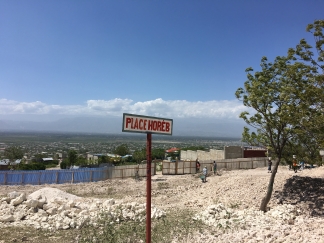news article
Haiti’s Promised Land: Building new lives
July 19, 2017 / By Melinda Miles, Coordinator, Haiti Takes Root
In March 2010, Canaan was a mix of floodplain and foothills, a desert scorching in the midday sun. It was a far cry from the forests of hardwood trees that stood there a hundred years ago, although a breathtaking view of the Bay of Port-au-Prince and seeing the hazy capital itself across the sparkling water gave the place a sense of hope.
The first residents arrived just two short months after a 7.0 earthquake had shattered their lives, and before long, the foothills were dotted with makeshift shelters. As people were evicted from the displacement camps, they sought refuge in the desert, and many were drawn to the dream of having their own land. Nearly every day for six years, families continued to arrive.
The people named it Canaan because it would be their promised land. Without aid agencies or government support, 250,000 people constructed homes, businesses, roads, churches, public spaces, schools, and markets. After living through the terror of the earth shaking their world to ruins, these people had faith enough to go out into the barren desert, draw property lines in the sand, and use their own hands to build a new life.
Today Canaan is Haiti’s third largest urban area, and it has approximately the same population as Buffalo, NY. However, that is where the similarities between the two cities end: Canaan exists in less than 40 percent of the space Buffalo takes up, and although areas of Canaan are mixed income, the vast majority of its residents are extremely poor and live in substandard housing, without latrines or clean water.
The first time I saw Haiti, I was stunned by the poverty. The idea that nearly half of the world’s people live in extreme poverty with less than $2.50 per day is very abstract when you haven’t seen it, and in Haiti, it’s even more severe: 80 percent of families live in extreme poverty and more than 50 percent live on less than $1.00 per day. T hose families are lucky to eat a meal once every other day.
hose families are lucky to eat a meal once every other day.
My first visit was a short mission trip with my high school, and what I saw challenged my beliefs, including what it means to be a Christian. The poverty I witnessed in Haiti made me question the existence of God in that way we do when something just seems too terrible to be true. How could God let so much suffering and misery exist?
At the same time, I was clear about what Jesus taught: treat others the way you want to be treated. Not only that, but serve those who do not have what you have. He called on his followers to work for the poor and the vulnerable, to clothe the naked, and feed the hungry.
So for me the question is this: in a world with inequality this vast, where the majority of the world’s families live in poverty, how do we live our faith, and what does it mean to trust that God is enough?
As Reverend Patricia Walz of Baldwinsville First United Methodist Church said, “Sometimes, God’s people need to step forward as Jesus would do.” We
can trust that God is enough because his teachings are very clear in that every single one of us is called to serve. We can trust that when we live our faith and take the steps to make the world better, we are being true Christians – we prove the existence of God through our actions.
In Haiti, you don’t find many people sitting around; everyone is always working to survive. You don’t hear talk of hopelessness because people can’t afford to lose hope. They trust in God because they trust in themselves; their faith fuels their courage to get through each day.
While Canaan is an example of what faith can build, the story isn’t over yet. Working in partnership with a network of neighborhood committees and community groups, my team at J/P Haitian Relief Organization is planting trees to create green spaces and protect this new city from the harmful impacts of climate change, especially flooding and landslides. Although Canaan is a new life for thousands of families, this quality of this life is still poor – very few trees mean no shade for children to play in, for youth to study, for women to do the laundry.
This is where you come in. We are seeking partners for our new Adopt a Park program. The Baldwinsville First community is the very first to Adopt a Park in Canaan, and hopefully their example will help us spread green across the desert. To learn more visit: www.jphro.org.